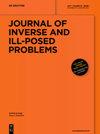Multi-coil MRI by analytic continuation
IF 0.9
4区 数学
Q2 MATHEMATICS
引用次数: 0
Abstract
Abstract We present novel reconstruction and stability analysis methodologies for two-dimensional, multi-coil MRI, based on analytic continuation ideas. We show that the 2-D, limited-data MRI inverse problem, whereby the missing parts of解析延拓的多线圈MRI
摘要基于解析延拓思想,提出了一种新的二维多线圈MRI重建和稳定性分析方法。我们证明了二维有限数据MRI反问题,其中𝐤{\mathbf{k}}空间(傅里叶空间)的缺失部分是平行于k1 {k_{1}}或k2 {k_{2}}的线(即𝐤{\mathbf{k}} -空间轴),可以简化为一组一维Fredholm型反问题。然后求解Fredholm方程以恢复一维线轮廓上的二维图像(“逐片”成像)。该技术在一系列医学活体图像(例如,脑、脊柱、心脏)和幻影数据上进行了测试。与文献中的类似方法相比,当对𝐤{\mathbf{k}}空间数据进行随机子采样以模拟运动损坏时,我们的方法在结构相似性方面显示出最佳性能。此外,我们给出了奇异值分解(SVD)和Fredholm算子的稳定性分析,并比较了不同𝐤{\mathbf{k}} -空间子采样方案(例如随机与均匀加速采样)的稳定性。
本文章由计算机程序翻译,如有差异,请以英文原文为准。
求助全文
约1分钟内获得全文
求助全文
来源期刊

Journal of Inverse and Ill-Posed Problems
MATHEMATICS, APPLIED-MATHEMATICS
CiteScore
2.60
自引率
9.10%
发文量
48
审稿时长
>12 weeks
期刊介绍:
This journal aims to present original articles on the theory, numerics and applications of inverse and ill-posed problems. These inverse and ill-posed problems arise in mathematical physics and mathematical analysis, geophysics, acoustics, electrodynamics, tomography, medicine, ecology, financial mathematics etc. Articles on the construction and justification of new numerical algorithms of inverse problem solutions are also published.
Issues of the Journal of Inverse and Ill-Posed Problems contain high quality papers which have an innovative approach and topical interest.
The following topics are covered:
Inverse problems
existence and uniqueness theorems
stability estimates
optimization and identification problems
numerical methods
Ill-posed problems
regularization theory
operator equations
integral geometry
Applications
inverse problems in geophysics, electrodynamics and acoustics
inverse problems in ecology
inverse and ill-posed problems in medicine
mathematical problems of tomography
 求助内容:
求助内容: 应助结果提醒方式:
应助结果提醒方式:


